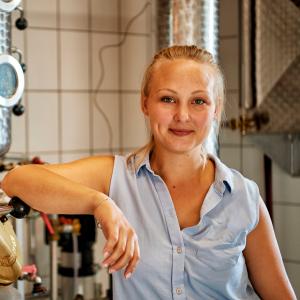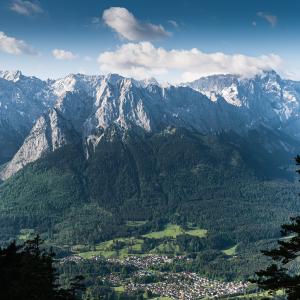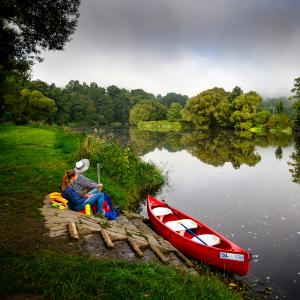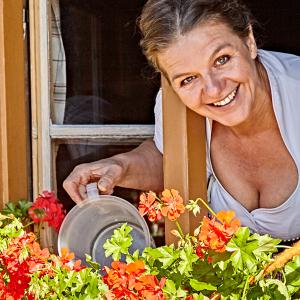Franconia has delightful towns and cities with lots of historical charm, art and culture. All over the region the tastiest beers are brewed, and wherever you are it's only a stone's throw to the picturesque natural landscapes in the surrounding areas. So why not recommend these eight towns and cities to your customers?
Aschaffenburg: a little piece of the South in the far West
'My Bavarian Nice' was what King Ludwig I called Aschaffenburg, the Franconian town in the extreme north-west of Bavaria. His reasons? The mediterranean flair of the town and its mild climate. But today too, great pleasure and dolce vita can be enjoyed in Aschaffenburg, with its many inviting cafés and restaurants. The 'Discover the South' tour includes many of the most beautiful sights, among them the magnificent renaissance castle Johannisburg, built in red sandstone, one of whose features is the State Picture Gallery with works by Lucas Cranach the Elder. A highlight of the castle gardens is the Saint-Germain terrace, above the banks of the Main, where fig trees, cypresses, agaves and almond trees contribute to create a wonderful mediterranean flair. Then on via the Pompejanum which, as a replica of a Roman villa in Pompeii, was intended to celebrate the culture and aesthetics of the ancient world, to the old town of Aschaffenburg with its idyllic half-timbered houses and lanes. Here, your customers can immerse themselves thoroughly in that Franconian homeliness
Aschaffenburg Tourism
Tel. +49 6021/395-800
E-mail: info@tourist-aschaffenburg.de
Bamberg: a synthesis of the arts in all the loveliness of Nature
Welcome to Germany's largest intact historical town centre! Because Bamberg escaped bombardment in the Second World War to a great extent, there are still 1200 original historical monuments crowded together here. With half-timbered buildings, arched bridges over the Regnitz, the old town hall and the Romanesque imperial cathedral – the history of this UNESCO World Cultural Heritage town, built on seven hills, goes back more than 1000 years. Not far from the pedestrian precinct is the so-called gärtnerstadt (market gardeners' district), a part of the town in which many of the inhabitants grow vegetables. For centuries now, the people of Bamberg have been exporting their vegetables out beyond the town boundary. And the country around Bamberg beckons with wonderful landscapes, nature parks, castles and small breweries. Franconian Switzerland, the Steigerwald, the nature park Hassberge and the region of Obermain-Jura are simply wonderful for hiking, cycling, discovery and relaxation.
Bamberg Tourism
Tel.: +49 951/2976-200
E-mail: info@bamberg.info
Bayreuth: a music town – yet right up close to the mountains
Margravine Wilhelmine had the Bayreuth Opera House built in 1748. From the outside, the wooden building has a sober look to it, but on the inside it simply overwhelms visitors with its late baroque resplendence and magnificence in tones of green and gold. The opera house, fully preserved, is part of the UNESCO World Cultural Heritage today. The Margravial Opera House also attracted the composer Richard Wagner. However, he thought it was too small and had a theatre of his own built on the town's 'Green Hill': the Bayreuth Festival Theatre. Without grandeur, but with unique acoustics. Since 1876, the world-famous Bayreuth Festival has been taking place there each summer. However, Bayreuth is not only known for the opera, but also for its beer: In the 'Franconian Brewery Museum' your customers can gather any amount of information about the history of beer and brewery culture. Or perhaps you might prefer a little Nature? Bayreuth's location between the Fichtel Mountains and Franconian Switzerland is simply ideal for aficionados of the outdoor life. The highest mountains in the Central German Uplands reach heights of up to 1000 metres. In Franconian Switzerland, some 30 kilometres away, climbers, adventurers and castle fans will find their paradise – with innumerable climbing routes, 1000 caves and almost 100 castles.
Bayreuth Marketing & Tourism GmbH
Tel.: +49 921 885–88
E-mail: info@bayreuth-tourismus.de
Coburg: lots of culture in just a small area
For centuries, this former royal seat in the north of Bavaria was a ducal residence and meeting place for the high nobility of Europe. To this very day, impressive edifices bear witness to that glory: Callenberg Castle, situated to the north-west of the town and still in the possession of the ducal family, and also the castles of Ehrenburg and Rosenau and the 'Crown of Franconia', as the 'Veste Coburg' (Coburg Fortress) – sitting in solitary splendour high up above the town – is called. The latter is one of Germany's largest and best preserved mediaeval castle buildings. In the Coburg art collections, it is home to valuable artistic, cultural and historical exhibits, once collected by the dukes of Coburg. Yet the town is also famous for its many music festivals and other festivities. For example, why not recommend your customers to visit to the biggest samba festival outside Brazil?
Coburg Marketing
Tel.: +49 9561 898000
E-mail: marketing@coburg.de
Dinkelsbühl: the living open-air museum
Towers and gates surround one of Germany's best preserved mediaeval towns. The landmark of the town is the Bäuerlin Tower. This half-timbered tower on the bank of the Wörnitz got its name from the watchman and tanner Hans Bäuerlin. But there is a considerably larger edifice that graces the old town of Dinkelsbühl: St. George's Minster. It is one of the most beautiful late Gothic hall churches in southern Germany with a Romanesque tower portal. Around the church, your customers can admire many half-timbered and gabled houses: for example the large granary dating from 1508, home to a youth hostel today, and then there's the armoury of the Dinkelsbühl kinderzeche (children's feast), the Hezelhof, the new town hall, the Castle of the Teutonic Order and the House of History. There, 800 years of town history come to life again – from the origins of the kinderzeche, the historical regional festival in Dinkelsbühl, through to the time of the witch hunts. And the infirmary dating from 1280 is also impressive. This building, with its artistic half-timbered gable, was once the town orphanage. Today, it houses the theatre in the hospital courtyard, a concert hall and the art vault.
Tourism Service Dinkelsbühl
Tel.: +49 9851 902440
E-mail: touristik.service@dinkelsbuehl.de
Nuremberg: regional capital – with a double castle
The capital of Franconia has always had great magnetism: in the Middle Ages the emperors of the Holy Roman Empire resided in this double castle. The complex, on a steep sandstone rock, consists of the Imperial Castle and the Burgrave's Castle. Rich patricians and merchants erected magnificent houses and gardens on the city wall, which has remained fully preserved until today. Just next door is the district of Gostenhof, formerly a working-class area, and now a trendy place to hang out. Also worth seeing is the site of the Nuremberg Palace of Justice. Between 1945 and 1946 the cases relating to war crimes perpetrated by high-ranking representatives of the National Socialist regime were heard here. And in the documentation centre on the former Nazi party rally grounds, your customers can learn a good deal about the propaganda events the National Socialists held here. An absolute must, above all in the Advent season, is the main market, on which the famous Nuremberg Christmas Market (known as the Christkindlesmarkt) is held, the oldest in the world. But that is not the only opportunity your customers will have to taste those much loved Nuremberg specialities: gingerbread and Nuremberg barbecue sausages, traditionally eaten with sauerkraut and hot mustard.
Congress and Tourism Centre Nuremberg
Tel.: +49 911 2336-0
E-Mail: tourismus@nuernberg.de
Rothenburg ob der Tauber: romantic half-timbered town with a love of Christmas
As if it had come out of a picture book: a fully preserved wall with 42 gate towers and other fortified towers protects this mediaeval old town. Lovingly renovated half-timbered houses with window boxes, winding lanes with cobblestones, churches, fountains, gardens and a little moated castle all go together to make Rothenburg, over 1000 years old, what may perhaps be Germany's most romantic town. So it's no surprise that it is situated on the 460-kilometre Romantic Road. What is more: in the historical marketplace Christmas is celebrated the whole year round – in Käthe Wohlfahrt's Christmas village. The Christmas village has the world's largest selection of traditional German Christmas decorations, and everything else that accompanies the Christmas festival ... 365 days of the year! In the Christmas Museum – the only one of its kind in the world, by the way – visitors can learn all about Advent calendars, cribs and the loveliest Christmas customs.
Rothenburg Tourism Service
Tel.: +49 9861/404-800
E-mail: info@)rothenburg.de
Würzburg: ancient diocesan city amidst the vineyards
Würzburg has a wonderful location right on the Main and in between steep vineyards: on one bank, the Marienberg fortress sits enthroned on a hill 100 metres high. On the other, the massive Würzburg Residence. This large castle, with its 300 sumptuous rooms and its stairwell with the largest ceiling fresco in the world, was designed by Balthasar Neumann, the great star architect of south German baroque. Together with the extensive courtyard garden, it is part of the UNESCO World Cultural Heritage. It is regarded as one of Europe's most beautiful castles. On the old Marienberg bridge, locals and visitors meet up in the late afternoon to enjoy a glass of wine, following the custom known as brückenschoppen (drinks on the bridge). If your customers want to learn more about Franconian wine: Würzburg is the perfect starting point for discovery tours out into the surrounding wine-growing areas.
Congress-Tourismus-Würzburg
Tel. +49 9 31/ 37 23 35 (Tourist Information)
E-mail: tourismus@wuerzburg.de



